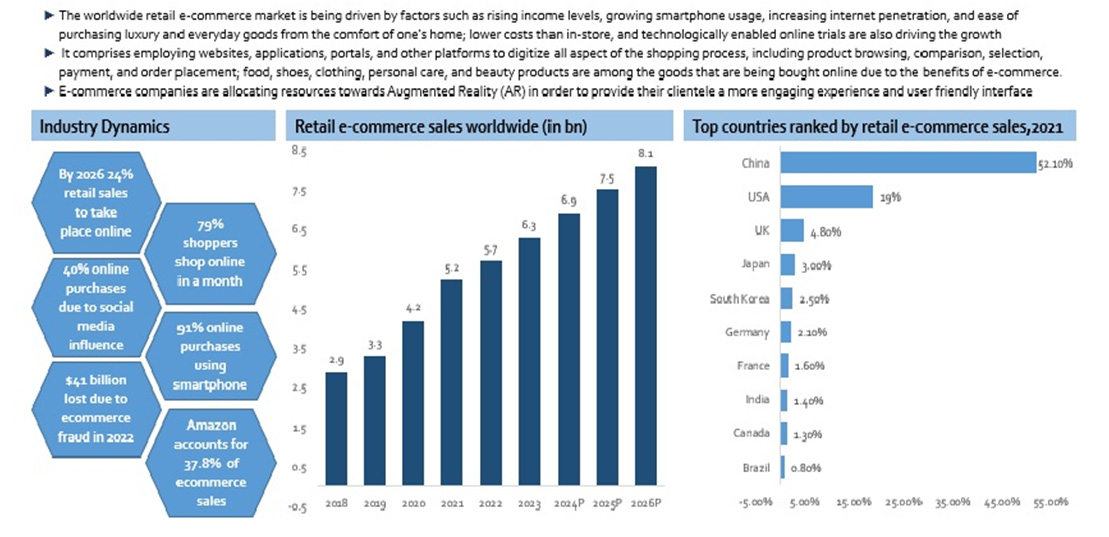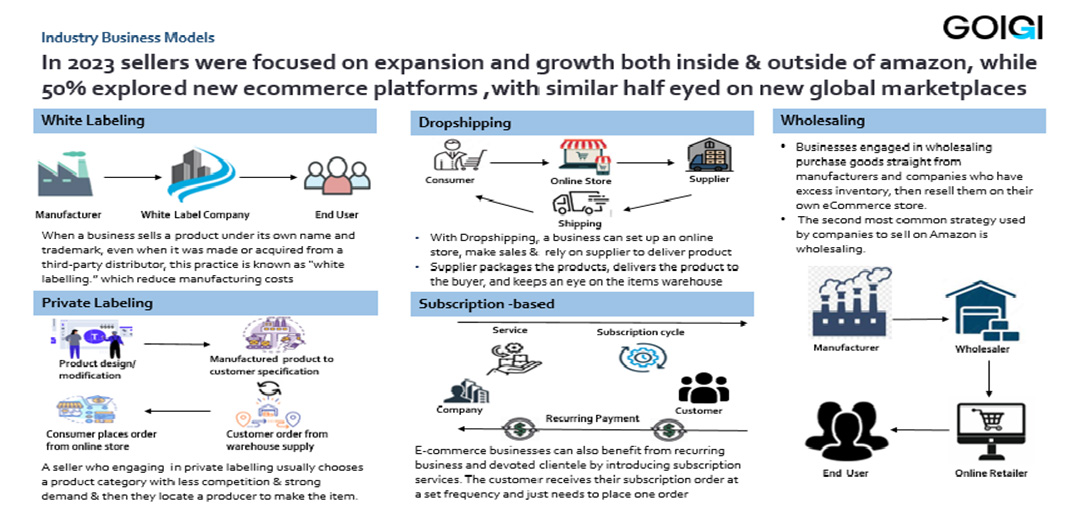

Download Entire report
Pay $4.99The size of the worldwide retail e-commerce market was estimated at $5.38 trillion in 2022, and it is projected to expand at a CAGR of 10.5% between the forecast periods of 2023 to 2030

Online customers most frequently give up on their carts due to unexpected expenses like shipping, taxes, and fees (48%).
It is anticipated that retail mcommerce will represent 43.4% of retail ecommerce sales in 2023, up from 41.8% in 2022.
The Middle East and Africa region is predicted to see $116.8 billion in B2C ecommerce sales in 2023, and by 2027, that amount is estimated to have increased to $168.8 billion
Social media is where millennials shop the most; in the US, 55% of those between the ages of 18 and 24 had made a purchase via social media.
The desire for individualized experiences is expected to increase, as indicated by the 59% of consumers who say they are more excited than uneasy about merchants using their preferences and past purchases to tailor their shopping experiences.
As of 2022, Alibaba Group, based in China, had an anticipated sales value of $780 billion (USD), making it the largest e-commerce retailer globally.

Transaction Risks
The buyer may dispute that he placed the purchase, the seller may dispute that the items were delivered to the wrong address, the expected delivery does not happen, or the customer may dispute that he ever placed the order
Therefore, in e-business, there is a chance that a default in order taking/giving, delivery, and payment will affect the seller or the customer.
Data Privacy and Security Risks
A significant amount of consumer data, including financial and personal data, is frequently stored by e-commerce companies and these databases could be the target of cybercriminals, which could result in data breaches and possible identity theft
Website Downtime Risks
Website downtime might have a number of reasons; first there could be a technical issue with the hosting service, or the server being used might not be able to handle spikes in traffic; alternatively, software that is connected to your website—like a plug-in—might malfunction and bring the entire thing down
E-Skimming
In order to steal sensitive data including credit card numbers and personal information of customers—a bad actor could insert malicious software into the checkout page of an online store. This kind of attack can cause a company's reputational harm

Multichannel Sales Strategy
To satisfy the demands of today's consumers, the entire client purchasing procedure must be simple; company can need a multichannel sales strategy that includes social commerce and marketplaces in order to enable this simple experience
Inventory and order management automation
A linked automation system can enable trigger events for reordering and guarantees that your company always has an accurate, real-time picture of orders compared to available stock.
This advanced automation makes sure that your online store doesn't lose out on any sales. In order to eliminate still another manual step from the inventory management process, automated solutions can even initiate these orders
Encryption of Data
Encryption plays a vital role in data protection. It stops unwanted access by converting your private information into a code; since no one can read encrypted data without the decryption key, it is safe even in the event of a data breach.
Staff Training Programs
A staff training program should include recognizing system-wide hazards in addition to potential risks related to each employee's role & employees will be more conscious of how their individual activities can affect the organization as a whole
1. Industry Overview
2. Market Insights
3. Industry Business Models(1/2)
4. Industry Business Models(2/2)
5. Retail Ecommerce Industry- Opportunities & Challenges
6. Retail Ecommerce Industry- Trends
7. Retail Ecommerce Industry- Risk & Mitigation Strategies
8. Retail Ecommerce Industry- Demand Drivers
9. Retail Ecommerce Industry- Price Analysis
10. Retail Ecommerce Industry- Cost Analysis
11. Retail Ecommerce Industry- Recent Updates
12. Retail Ecommerce Industry- Competitive Benchmarking
13. Retail Ecommerce Industry- Company Analysis (1/2)
14. Retail Ecommerce Industry- Company Analysis (1/2)
15. Retail Ecommerce Industry- Furniture and Homeware Segment(1/2)
16. Retail Ecommerce Industry- Furniture and Homeware Segment(2/2)
17. Retail Ecommerce Industry- Porter Five Forces Analysis
18. Retail Ecommerce Industry- SWOT Analysis
19. Retail Ecommerce Industry- Company Segmentation
Download Entire report
Pay $4.99Contact Us Today, And Get Reply Within 24 Hours!
Thank you! We have received your message. You will soon hear back from us.
Contact Us Today, And Get Reply Within 24 Hours!
Thank you! We have received your message. You will soon hear back from us.
Contact Us Today, And Get Reply Within 24 Hours!
Thank you! We have received your message. You will soon hear back from us.